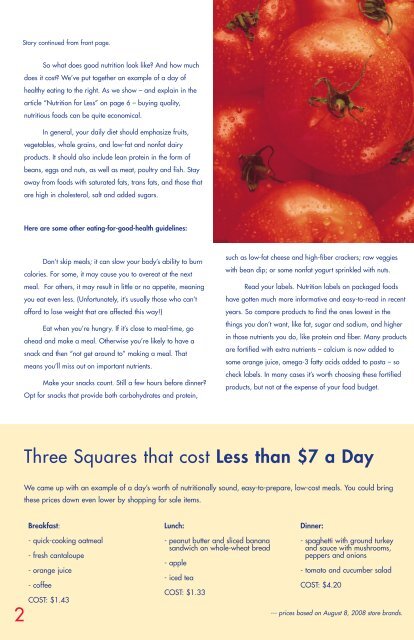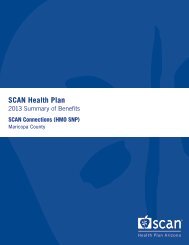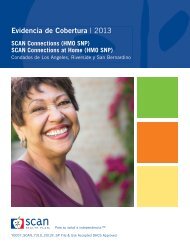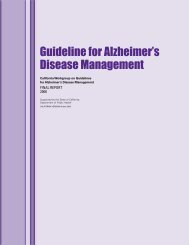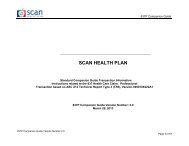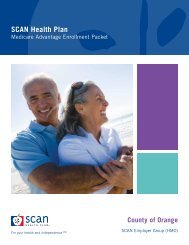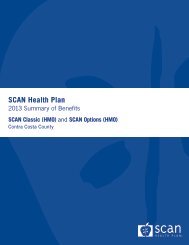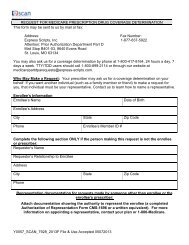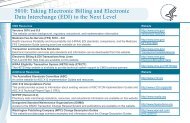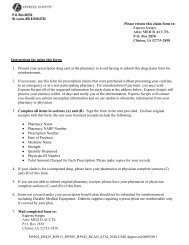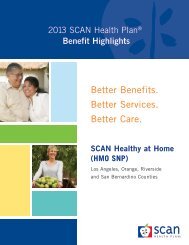INSIDE - SCAN Health Plan
INSIDE - SCAN Health Plan
INSIDE - SCAN Health Plan
Create successful ePaper yourself
Turn your PDF publications into a flip-book with our unique Google optimized e-Paper software.
Story continued from front page.<br />
So what does good nutrition look like? And how much<br />
does it cost? We’ve put together an example of a day of<br />
healthy eating to the right. As we show – and explain in the<br />
article “Nutrition for Less” on page 6 – buying quality,<br />
nutritious foods can be quite economical.<br />
In general, your daily diet should emphasize fruits,<br />
vegetables, whole grains, and low-fat and nonfat dairy<br />
products. It should also include lean protein in the form of<br />
beans, eggs and nuts, as well as meat, poultry and fish. Stay<br />
away from foods with saturated fats, trans fats, and those that<br />
are high in cholesterol, salt and added sugars.<br />
Here are some other eating-for-good-health guidelines:<br />
Don’t skip meals; it can slow your body’s ability to burn<br />
calories. For some, it may cause you to overeat at the next<br />
meal. For others, it may result in little or no appetite, meaning<br />
you eat even less. (Unfortunately, it’s usually those who can’t<br />
afford to lose weight that are affected this way!)<br />
Eat when you’re hungry. If it’s close to meal-time, go<br />
ahead and make a meal. Otherwise you’re likely to have a<br />
snack and then “not get around to” making a meal. That<br />
means you’ll miss out on important nutrients.<br />
Make your snacks count. Still a few hours before dinner?<br />
Opt for snacks that provide both carbohydrates and protein,<br />
such as low-fat cheese and high-fiber crackers; raw veggies<br />
with bean dip; or some nonfat yogurt sprinkled with nuts.<br />
Read your labels. Nutrition labels on packaged foods<br />
have gotten much more informative and easy-to-read in recent<br />
years. So compare products to find the ones lowest in the<br />
things you don’t want, like fat, sugar and sodium, and higher<br />
in those nutrients you do, like protein and fiber. Many products<br />
are fortified with extra nutrients – calcium is now added to<br />
some orange juice, omega-3 fatty acids added to pasta – so<br />
check labels. In many cases it’s worth choosing these fortified<br />
products, but not at the expense of your food budget.<br />
Three Squares that cost Less than $7 a Day<br />
We came up with an example of a day’s worth of nutritionally sound, easy-to-prepare, low-cost meals. You could bring<br />
these prices down even lower by shopping for sale items.<br />
Breakfast:<br />
Lunch:<br />
Dinner:<br />
2<br />
- quick-cooking oatmeal<br />
- fresh cantaloupe<br />
- orange juice<br />
- coffee<br />
COST: $1.43<br />
- peanut butter and sliced banana<br />
sandwich on whole-wheat bread<br />
- apple<br />
- iced tea<br />
COST: $1.33<br />
- spaghetti with ground turkey<br />
and sauce with mushrooms,<br />
peppers and onions<br />
- tomato and cucumber salad<br />
COST: $4.20<br />
--- prices based on August 8, 2008 store brands.


